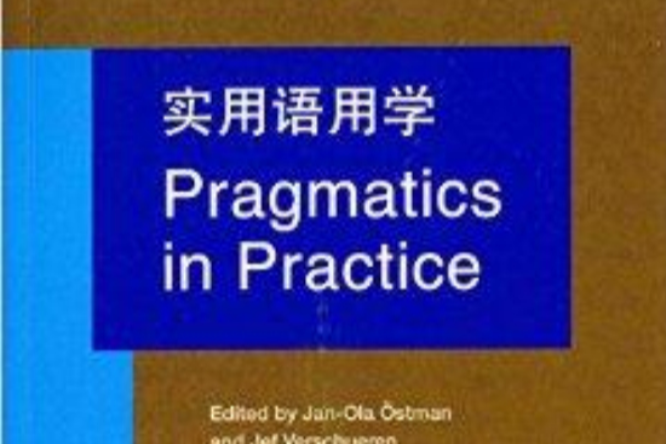《實用語用學》是2014年上海外語教育出版社出版的圖書,作者是歐斯特曼 (Ostman J) Jef Verschueren。
基本介紹
- 中文名:實用語用學
- 作者:歐斯特曼 (Ostman J) Jef Verschueren
- 出版社:上海外語教育出版社
- 出版時間:2014年8月1日
- 頁數:324 頁
- 開本:16 開
- ISBN:9787544637732
- 外文名:Pragmatics in Practice
- 語種:簡體中文, 英語

《實用語用學》是2014年上海外語教育出版社出版的圖書,作者是歐斯特曼 (Ostman J) Jef Verschueren。
《實用語用學》是2014年上海外語教育出版社出版的圖書,作者是歐斯特曼 (Ostman J) Jef Verschueren。內容簡介《實用語用學》內容簡介:語用學已經是研究使用中的語言了,那么“前沿叢書”的最後一本實用...
《語言學實用教程》是2010年1月1日高等教育出版社出版的圖書,作者是趙忠德,趙永青。該書主要論述語言的本質、特徵及其功能等內容。內容簡介 本書共分八章。第一章引言部分,主要論述語言的本質、特徵及其功能,介紹語言學研究中的一些...
《英語語言學實用教程》是2007年3月蘇州大學出版社出版的圖書,作者是陳新仁。本教材的主要特色為:面向英語的語言學。從各種渠道選取大量有趣、典型、題材各異的英語素材,全方位探索英語的基本規律,體現真正的“英語”語言學,同時適當...
《語用學教程》是2004年7月北京大學出版社出版的圖書,作者是索振羽。內容簡介 語用學是20世紀70年代、80年代由西方學者們建立和發展起來的語言學的一門獨立的新學科。《語用學教程》這本小冊子是在1996年和1998年先後兩次為北京大學...
《英語語言學實用教程第二版》是2017年6月1日蘇州大學出版社出版的圖書,作者是陳新仁。內容簡介 本書在原書基礎上增加了3個新單元,將原先兩個關於語言學研究方法的單元改為供學習者自學用的附錄,主要內容包括緒論、語音、結構、語義...
《語用學教程(第二版)》是2014年北京大學出版社出版的圖書,作者是索振羽。內容簡介 本書系統介紹語用學領域西方學者提出的基本理論和方法,把經過檢驗證明是穩妥的、有價值的理論和方法編入教材,同時也注重在介紹、研究過程中發現不...
《現代漢語語用學》是2014年華中科技大學出版社出版的圖書,作者是孫汝建。內容:語用學的分支、概念、套用等。內容簡介 本書從符號出發,把語用學分為小語用、中語用、大語用。在小語用層面上分析了與句法有關的話題、說明、表達重心...
《什麼是語用學》是2011年出版的圖書,作者是俞東明。內容介紹 語用學自20世紀70年代興起以來,已發展成為語言學研究中一個成熟的 ,相對獨立的分支。由俞東明主編的《什麼是語用學》用通俗易懂的語言,通過問答的形式,向讀者介紹了...
《語用學在語文教學中的運用》是1996年杭州大學出版社出版的圖書,作者是王建華。內容簡介 本書在作者多年教學與科研實踐的基礎上編寫而成。全書比較系統地論述了檔案信息組織與檢索的基本原理和方法,著重對檔案信息組織與檢索的方法和技術...
聶丹,女,文學博士,北京語言大學教授,研究領域涉及漢語作為第二語言的測試與教學、國語測試與教學、語用學、話語分析等。作為項目負責人或重要成員參與多項科研課題。出版專著3部,合著1部;發表學術論文30餘篇。曾入選北京市中青年...
陳爭峰,副教授,碩士生導師,西安電子科技大學碩士,2014-2015年度劍橋大學訪問學者,主要開設“新實用漢英翻譯課程”、“筆譯技巧與實踐”等課程。 研究領域:外語教學、翻譯以及敘事學。 聶琳,副教授。
《語用學引論》是2016年12月雲南大學出版社出版的圖書,作者是文健。內容簡介 本書較為全面地介紹了語用學的經典理論。從具體的語言現象出發,永生動實用的語言材料進行分析和論證,引導讀者從具體的語言事實中理解和掌握語言使用的原則...
《新編大學英語專業實用語法》旨在教會學生如何在語言交際中運用英語語法,幫助他們發現和克服常犯的語法錯誤。《新編大學英語專業實用語法》最大的特點是,將語法學習與跨文化交際和語用學相結合。全書共分20章,每章均以診斷測試開頭,...
本屆語用學研討會圍繞語用學的基本理論、言語行為、禮貌原則、語用推理、認知語用學、語篇語用學、實用語用研究、跨文化語用學、法律語用學、語用學與教學、歷史語用學等若干主題進行,發言和討論在一個主會場和六個分會場內同時或...
2. 英語學術語用能力研究(編號:11YYC012),江蘇省2011年度社會科學基金青年項目,主持人,結項;·3. 《中國英語學習者會話增量行為習得研究》。北京:中國社會科學出版社,2011年10月。(獨著)·4. 《英語學術論文寫作實用教程》...
《語用學視角下的英語修辭格新探》,是2023年浙江大學出版社出版的圖書,作者是黃建濱。內容簡介 該書重點探討英語常用的修辭格,對英語修辭格進行合理的分類,說明各修辭格的功能、分類、使用領域等,對相近的修辭格進行對比分析,通過...
《英語習語研究:語用學視角》具有理論研究與實際套用相結合的特點,對於廣大的英語學習者和英語語言研究者來說,既有理論指導作用,又有實用價值。作者簡介 彭慶華,雲南民族大學英語專業副教授,上海交通大學外國語學院博士研究生 目錄信息...
cognitive unit in Chinese, WORD vol 49, No 3, Dec 1998: 383-403;"從指代研究看新格萊斯語用學的實用性"《外國語》1997 年第 3 期;"含義分類標準評析"《外語教學與研究》1997 年第 2 期;"語用學和認知語境"《外語學...
